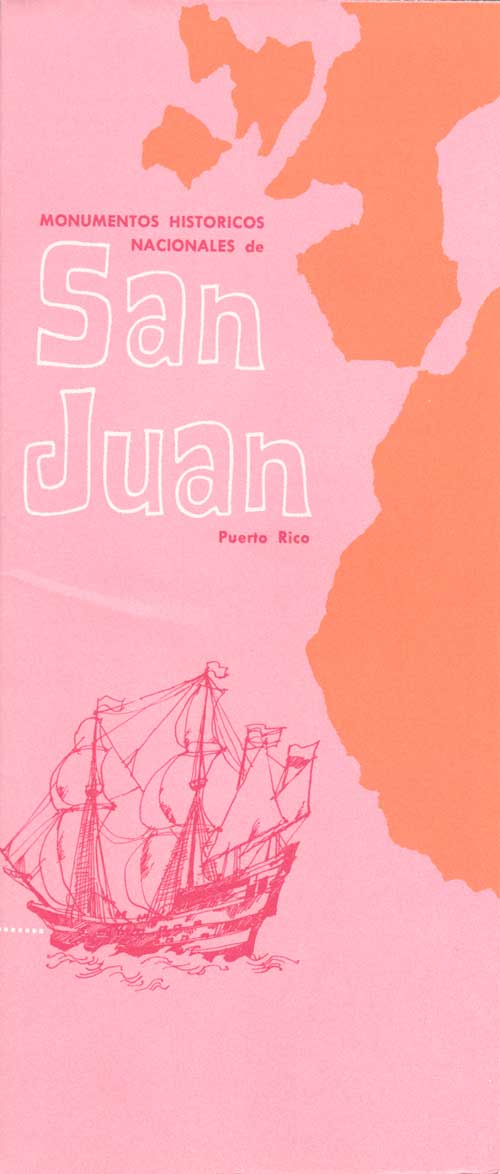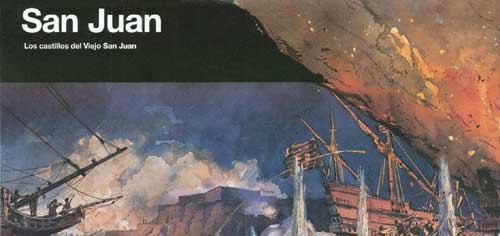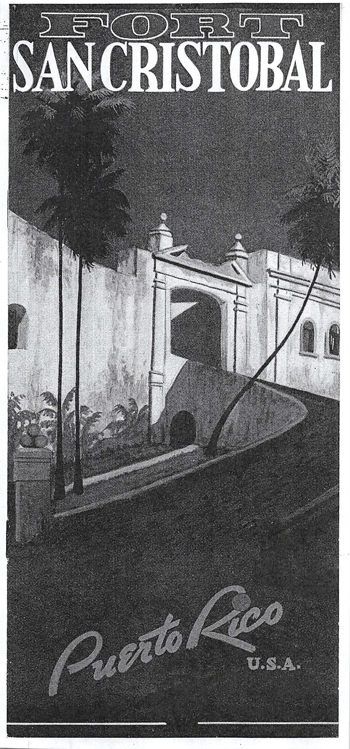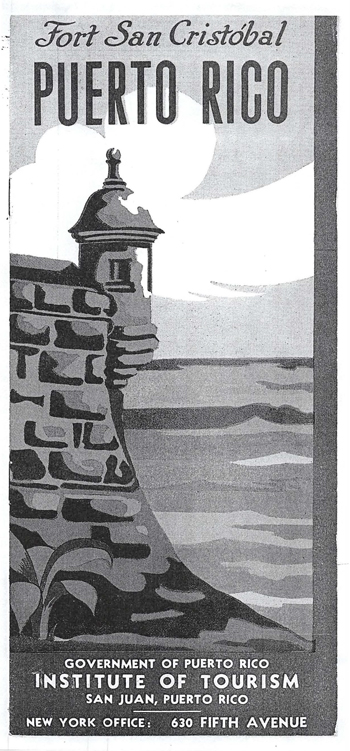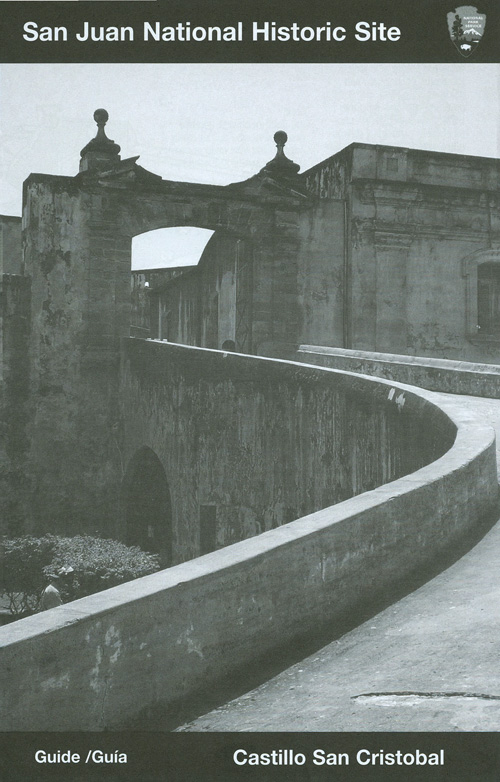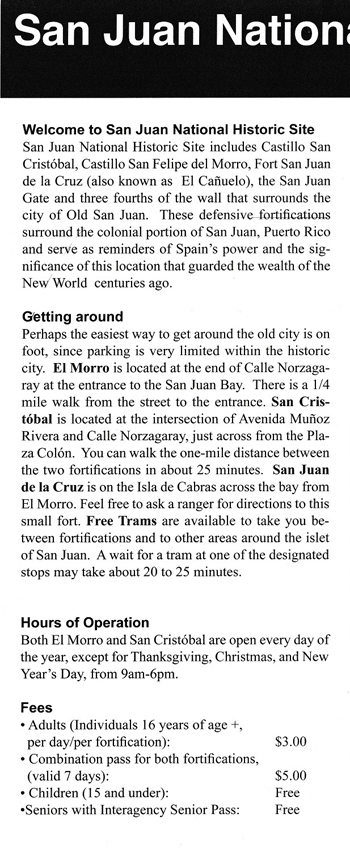|
San Juan National Historic Site Puerto Rico |
 |
 NPS photo | |
"We never travel to the past, the buildings take us there..."
—Arleen Pabón, Architectural Historian
"Al pasado nunca vamos, nos llevan los edificios..."
—Arleen Pabón, arquitecta historiadora
WHY HERE?
Feel the wind: The trade winds blew sailing ships here from Europe, helped by ocean currents.
Why would Spain fortify Puerto Rico? Because it was the first major island with water, shelter, and supplies that sailing ships came to en route to the Americas from Europe via Africa's west coast.
Why on this small islet? Because its deep bay was an excellent port, readily defended.
Why such a massive, complex system of fortifications, built over 10 generations, 250 years? Because the system was an imposing barrier to wealth beyond belief—in gold, silver, gems, spices, and furs from Mexico and Central and South America. Spain would then control Puerto Rico from 1508 to 1898. In 1492 Spain had been Europe's door to the Muslim world of the East via North Africa for 700 years. Now Spain possessed the key to a New World—the Western Hemisphere.
¿POR QUÉ AQUÍ?
Sienta la brisa. Los vientos alisios y las corrientes maritimas impulsaban los barcos desde Europa.
"¿Por qué España fortificaría a Puerto Rico?" Porque era la primera antilla mayor que podia proveer agua, albergue y suministros a los barcos que navegaban en ruta a Las Américas desde Europa y la costa occidental de África.
"¿Por qué en esta pequeña isleta?" Porque su bahia profunda era un puerto excelente y fácil de defender.
"¿Por qué este masivo y complejo sistema de fortificaciones construido por más de diez generaciones en 250 años?" Porque este sistema fue puerta de entrada inexpugnable a riquezas incalculables de oro, plata, piedras preciosas, especias y cueros de México, Centro América y Sur América. Puerto Rico fue posesión española entre 1508 y 1898. Para 1492 España, a través del norte de África, fue la puerta de Europa hacia el mundo musulmán por 700 años. Ahora, España poseía la llave al Nuevo Mundo, el Hemisferio Occidental.
The mainland coast of the Spanish Empire in the Americas was called THE SPANISH MAIN. From the 1500s through 1700s enormous New World riches supported Spain as a world power.
La costa que comprende EL IMPERIO ESPAÑOL en America. De los 1500s a los 1700s las enormes riquezas extraidas del Nuevo Mundo sostuvieron a España en su sitial como potencia mundial.
PUERTO RICO, "RICH PORT" The harbor could be protected by fortifying the islet at its mouth. Spain later built a small fort across the bay, EL CAÑUELO, to provide formidable crossfire. Puerto Rico helped Spain control access to its New World possessions.
PUERTO RICO La bahía se podia proteger fortificando la entrada de la isleta. Luego, España construyó un fortin al otro lado de la bahía, EL CAÑUELO, para proveer un formidable fuego cruzado. Puerto Rico ayudó a España a controlar el acceso a sus posesiones en el Nuevo Mundo.
Ten Generations in the Making
Under Juan Ponce de León, Spain displaced native Taíno Indians of Puerto Rico to control this strategic island. To help control the lands around the Caribbean, Spain built an impregnable system of defense in depth here. Wealth from the Americas made Spain a world power.
Diez generaciones de desarrollo
Bajo Juan Ponce de León, España desplazó a los taínos de Puerto Rico en el control de la estratégica isla. Para ayudar a controlar las islas que bordean al Caribe, España hizo construir aquí un inexpugnable sistema defensivo. Las riquezas de las Américas hicieron de España una potencia mundial.
1493
Columbus' 2nd voyage sights Puerto Rico
Colón, en su segundo viaje, avista a Puerto Rico
1508
Ponce de León starts Spanish colony
Ponce de León comienza la colonización de la Isla
1511
Native Taíno Indians revolt
Rebelión de los taínos
1521
San Juan city founded
Fundación de la ciudad de San Juan
1533
La Fortaleza, first fortification started
Comienza la construcción de La Fortaleza, la primera fortificación
1539
Castillo San Felipe del Morro started
Comienza la construcción del Castillo San Felipe del Morro
1595
First English attack, Sir Francis Drake
Primer ataque inglés al mando de Sir Francis Drake
1598
Second English attack, Sir George Clifford
Segundo ataque inglés, Sir George Clifford
1608
Fortin San Juan de la Cruz (El Cañuelo) started
Comienza la construcción del Fortin San Juan de la Cruz, 'El Cañuelo'
1625
Dutch attack, Boudwyn Hendrick
Ataque holandés, Boudwyn Hendrick
1634
San Juan city wall started Castillo San Cristóbal started
Se comienza a amurallar la ciudad Comienza la construcción del Castillo San Cristóbal
1660
El Cañuelo re-built
Reconstrucción de El Cañuelo
1783
Castillo San Cristóbal, major construction completed
Finaliza la construcción del Castillo San Cristóbal
1790
Castillo San Felipe del Morro, major construction completed
San Juan city wall completed
Finaliza la construcción del Castillo San Felipe del Morro
Se completa la muralla de la ciudad
1797
British attack, Sir Ralph Abercromby
Ataque británico, Sir Ralph Abercromby
1897
Part of city wall torn down to expand San Juan
Demolición de parte de la muralla de San Juan
1898
Spanish-American War, Puerto Rico becomes U.S. Territory
Guerra Hispanoamericana, Puerto Rico se convierte en territorio de los Estados Unidos
1899
San Juan Military Reservation established
El sitio histórico es designado San Juan Military Reservation
1943
Name change to Ft. Brooke honors first American governor
El nombre cambia Ft. Brooke en honor al primer gobernador norteamericano
1949
San Juan National Historic Site established
Se establece el San Juan National Historic Site
1983
World Heritage Site designated
Declarado Patrimonio Mundial
"Defense in Depth" Fortification System
The defense in depth system fortified the San Juan Islet with three lines of defense. The first, second, and third lines of defense were directed at protecting the mouth of San Juan Bay against enemy entry. This elaborate system testified to Puerto Rico's value for Spain's dreams of world empire. It marked the high point of 1600s and 1700s military engineering, when war and trade traveled on sailing ships.
Walk beneath El Morro's fortress walls on the Paseo del Morro and look across at Fortin San Juan de la Cruz, El Cañuelo, a half mile across the mouth of the bay at the Atlantic Ocean. This stretch of water could be covered by a deadly crossfire protecting this harbor, protecting Puerto Rico, the doorway to the riches of the New World. England, Holland, France, and Denmark coveted these riches. But Spain held the key, San Juan, Puerto Rico.
Sistema de "Defensa en Profundidad"
El sistema de "defensa en profundidad" de la isleta de San Juan incluía tres lineas defensivas. El objetivo de la primera, segunda y tercera linea defensiva iba dirigido a proteger la bahía de San Juan de ataques enemigos. El elaborado sistema fue testigo de la importancia de Puerto Rico en las aspiraciones imperiales de España. El sistema marcö el cenit de la ingenieria militar durante los 1600s y 1700s cuando la guerra y el comercio se hacian en barcos de vela.
Camine junto a los cimientos de las masivas murallas en el Paseo del Morro, mire al otro lado de la bahía y verá el Fortin San Juan de la Cruz, El Cañuelo, a media milla de la bahía en el Océano Atlántico. Este trecho de agua daba paso a un mortifero fuego cruzado contra las embarcaciones enemigas que intentaran adentrarse en la bahía. Esta era la puerta de entrada a las riquezas del Nuevo Mundo. Inglaterra, Holanda, Francia y Dinamarca las codiciaban pero España tenía la Nave, San Juan, Puerto Rico.
FORTIFICATION SYSTEM
Lands bordering the Caribbean Sea held the riches Spain needed to gain world power. Massive but intricate, the fortification system of defense in depth on San Juan Islet in Puerto Rico helped to make Spain's dream a long-lasting reality.Defense in depth began at the east end of San Juan Islet. Many structures no longer exist or are now in ruins. San Antonio Bridge to the main island was fortified. It stood in the line of fire of Fort San Geronimo at the islet's east end. To the north, Escambrón Battery also covered a hostile landing at the islet's tip.
A wall with a bastion crossed the islet's girth as the second line of defense.
The third line was the walled city and the two major fortifications, plus the Devil's Sentry Box and Fort La Perla oceanside and the San Francisco de Paula Battery and Las Palmas Bastion bayside.
SISTEMA FORTIFICADO
Las tierras que colindan al Mar Caribe poseian las riquezas que España necesitaba para convertirse en potencia mundial. Masivo y complicado, el sistema de defensa en profundidad de la isleta de San Juan de Puerto Rico contribuyó a hacer de los sueños españoles una realidad.El sistema de defensa en profundidad comenzó al este de la isleta de San Juan. Muchas de las estructuras ya no existen o están en ruinas. El puente que unía la isleta a la isla principal era el Puente Fortificado de San Antonio. Se encontraba en la linea de fuego del Castillo San Jerónimo en el extremo este de la isleta. En la punta norte la Bateria del Escambrón defendía la isleta de un desembarco enemigo.
Una muralla abastionada cruzaba la isleta de norte a sur en lo que era la segunda linea de defensa.
La tercera linea se componía de la ciudad amurallada y de las dos principales fortificaciones además de la Garita del Diablo, el Fortin de la Perla, la Bateria de San Francisco de Paula y el Bastión Las Palmas que vigilaban la bahía.
Castillo San Felipe del Morro, 'El Morro'
IT'S A HALF-HOUR WALK between the two major fortifications. You walk through Old San Juan, the walled city whose boldly colored houses and shops line its narrow streets watched over by grille-work balconies. Antiquity enfolds you—500 years of history planted soon after Columbus' second voyage, in 1493. An aerial photo orients you to these massive fortifications and outer defenses designed to disorient, unnerve, and exhaust an enemy. From the cruise ship piers it's a 10-minute walk to Castillo San Cristóbal, or take the free White Trolley to stops.
ES UN AGRADABLE PASEO DE TREINTA MINUTOS entre las dos fortificaciones principales. Camine a traves del Viejo San Juan, ciudad amurallada de casas con colores brillantes, calles estrechas y tiendas alineadas a ambos lados de la calle vigiladas desde lo alto por balcones con rejas. Lo antiguo le rodea, son 500 años de historia al establecerse la ciudad poco después del segundo viaje de Cristóbal Colón en 1493. Un aérea fotografía servirá para orientarle sobre estas enormes fortificaciones y defensas exteriores diseñadas para desalentar, desorientar y agotar al enemigo. Caminar desde los muelles de cruceros hasta el Castillo San Cristóbal le tomará unos diez minutos o puede tomar el transporte (trole) blanco para las paradas.
Castillo San Felipe del Morro, 'El Morro'
El Morro was built to protect San Juan Bay's deep harbor from attack by sea. It was the first good harbor for sailing ships en route to the New World after a one- or two-month Atlantic voyage from Europe.
El Morro evolved from a promontory with cannon (Level 1) to the massive, six-level fortress that confronts you today. It was worth Spain's investment: It protected Spain's access to New World wealth over most of 300 years. El Morro has endured as a masterpiece of military engineering from the 1500s to the present.
El Morro fue construido para proteger la profunda bahía de ataques maritimos. Fue la primera buena bahía en la primera de las Antillas Mayores donde los barcos podian atracar luego de uno a dos meses en el Oceano Atlantico desde Europa.
El Morro evolucionó de ser un promontor io con cañones (el nivel uno) para convertirse en la masiva fortaleza de seis niveles ante usted. La inversión de España valió la pena, protegiendo así el acceso de España a las riquezas del Nuevo Mundo por más de 300 años. El Morro ha resistido como obra maestra de ingenieria militar desde los 1500s hasta hoy.
LEVEL/NIVEL 1
Water battery
Lowest level
Batería flotante
Nivel inferiorLEVEL/NIVEL 2
Original tower
Torre originalLEVEL/NIVEL 3
Lower plaza
Plaza bajaLEVEL/NIVEL 4
Main firing battery
Batería principalLEVEL/NIVEL 5
Main plaza
Plaza principalLEVEL/NIVEL 6
Land defense
Highest level
Defensas terrestres
Nivel superior
Castillo San Cristóbal
Castillo San Cristóbal, with its sprawling outer defenses, was built over 150 years to protect El Morro and the city from land attack. Inspired by such attacks by rivals England (1598) and Holland (1625), it was designed by the Irish-born Chief Engineer Thomas O'Daly. O'Daly served Spain because Spain was an enemy of Ireland's enemy England.
Castillo San Cristóbal is the biggest European fortification in the Americas. It lost some outworks when part of the city wall was torn down in 1897 to expand the city of San Juan.
El Castillo San Cristóbal, con sus defensas exteriores, tomó 150 años en construirse para proteger El Morro y la ciudad de ataques por tierra. Construido como resultado de los ataques de rivales como Inglaterra (1598) y Holanda (1625), fue disehñado por el jefe de ingenieros, el irlandés Thomas O'Daly. O'Daly sirvió a España porque esta era enemiga de la rival de Irlanda, Inglaterra.
El Castillo San Cristóbal es la más grande fortificación europea en América. Perdio algunas de sus defensas exteriores con la demolición de segmentos de muralla en 1897. Esto para dar paso al crecimiento y desarrollo de la ciudad.
LEVEL/NIVEL 1
Main plaza
Lowest level
Plaza principal
Nivel inferiorLEVEL/NIVEL 2
Main firing battery
Batería principalLEVEL/NIVEL 3
Observation area
Highest level
Area de observación
Nivel superior
FEATURES OF A FORTRESS
Use this glossary to make sense of fortress features. Wells tapped massive cisterns storing a year's supply of rain water. Embrasures, openings atop walls, let soldiers fire while protected. Ramps provided access between levels. Casemates were used for storage and quarters.
Ravelins are outer defenses protecting the walls of the fortress. Loop-holes allowed for protected gunfire. Dry moats stopped enemies short of the fortress. Soldiers stood guard in sentry boxes. Bastions stuck out from walls so defenders could fire at enemies.
PARTES DE UNA FORTALEZA
Utilice este glosario para entender las partes que componen una fortificación. Pozos, encima de las cisternas que almacenaban agua de lluvia suficiente para un año. Tronera, espacios abiertos sobre las murallas para disparar cañones. Rampas, permitian el movimiento de cañones. Casamatas, utilizadas como cuarteles y almacenes.
Revellines, fortificaciones que protegían la muralla. Aspilleras, aberturas que protegían el fuego de fusiles en la fortificación. Fosos secos, detenían al enemigo que se acercaba a la fortaleza. Garitas, puestos de observación. Bastiones sobresalen de las murallas para disparar al enemigo.
 (click for larger map) |
FOR YOUR SAFETY Watch your step—and children—on these historic works, especially when rain makes them slippery! Sturdy footwear helps. Stay off walls and keep children off cannon and cannonball pyramids. Stay out of sentry boxes during storms. Pets must be on a leash on park a land and are not allowed in the fortifications. Service animals are welcome. Please use the trash receptacles. No food, drink, or smoking in the fortifications. Water is encouraged: please keep hydrated! For firearms regulations please visit www.nps.gov/saju.
POR SU SEGURIDAD Cuidado al caminar y vigile los niños y niñas. Use calzado apropiado ya que, cuando llueve, el suelo se torna resbaladizo. No camine sobre las murallas y mantenga a los pequeños alejados de los cañones y las pirámides de bombas. Manténgase fuera de las garitas durante tormentas. En terrenos del parque, las mascotas a deben mantenerse atadas, junto a su dueño(a) en todo momento y no se permiten dentro de las fortificaciones. Los perros guías son permitidos. Recuerde depositar la basura en los zafacones. En las fortificaciones esta prohibido comer, fumar y tomar bebidas, excepto agua. Por favor, manténgase hidratado. Para regulaciones sobre armas de fuego visite www.nps.gov/saju.
Source: NPS Brochure (2011)
|
Establishment
World Cultural Heritage Site — December 6, 1983 |
For More Information Please Visit The  OFFICIAL NPS WEBSITE |
Brochures ◆ Site Bulletins ◆ Trading Cards

Documents
Archaeological Excavation at El Morro, San Juan, Puerto Rico Notes In Anthropology Volume 6 (Hale G. Smith, 1962)
Cultural Landscape Report for the San Cristóbal Outworks, San Juan National Historic Site (Eliot Foulds and Alexandra von Bieberstein, 2015)
Cultural Landscape Report: San Juan Historic City Wall, San Juan National Historic Site, Puerto Rico (Panamerican Consultants, Inc., Wise, Janney, Elstner Associates, Inc. and Liz Sargent HLA, September 2021)
Cultural Landscapes Inventory: El Morro Esplanade, San Juan National Historic Site (July 2022)
Documento Fundacional, San Juan National Historic Site, Puerto Rico (Septiembre 2013)
Final General Management Plan/Environmental Assessment, San Juan National Historic Site, Puerto Rico (December 1984)
Finding Aid: Assembled Personal Papers Relating to the Spanish-American War and the History of Puerto Rico, 1898-1992 (History Associates, Inc., April 9, 2012)
Fortifications of San Juan (Date Unknown)
Foundation Document, San Juan National Historic Site, Puerto Rico (September 2013)
Foundation Document Overview, San Juan National Historic Site, Puerto Rico (November 2013)
Highlights of Porto Rican History (Ruth E. Butler, Date Unknown)
Historic Furnishings Report: El Castillo De San Cristóbal (José Ignacio Avellaneda, 1993)
Historic Structure Report: El Cañuelo, San Juan National Historic Site (WLA Studio, RAIO, Palmer Engineering and Building Conservation Associates, Inc., May 2018)
Historic Structure Report, Part I: Drawbridge and Sally Port of El Morro Castle San Juan NHS (Ricardo Torres-Reyes, June 1959)
Historic Structure Report: Quarter No. 211, San Juan National Historic Site Final (The COLLABORATIVE, Inc. and Atkinson-Noland & Associates, Inc., October 2016)
Historic Structure Report: Quarters 208 (Panamerican Consultants, Inc. and Wiss, Janney, Elstner Associates, Inc., May 2020)
Historic Structure Report: The Fortifications of San Juan National Historic Site, Vol. 1: Summaries, Conditions Survey, Recommendations, Glossary, Bibliography, Selected Historic Drawings, Appendices (Joan Berkowitz, E. Blaine Cliver, Richard Crisson, Billy Garrett, Judy Jacob, Frank Matero and Barbara Yocum, 1991)
Historic Structure Report: The Fortifications of San Juan National Historic Site, Vol. 2: El Fuerto de San Cristóbal (Joan Berkowitz, E. Blaine Cliver, Richard Crisson, Billy Garrett, Judy Jacob, Frank Matero and Barbara Yocum, 1991)
Historic Structure Report: The Fortifications of San Juan National Historic Site, Vol. 3: Castillo de San Felipe del Morro, The City Walls, An Investigation of the Materials Used, Cultural Landscape Report (Joan Berkowitz, E. Blaine Cliver, Richard Crisson, Billy Garrett, Judy Jacob, Frank Matero and Barbara Yocum, 1991)
Junior Ranger, San Juan National Historic Site (Date Unknown; for reference purposes only)
Junior Ranger (Spanish), San Juan National Historic Site (Date Unknown; solo para fines de referencia)
Long-Range Interpretive Plan, San Juan National Historic Site (September 2006)
Masonry Forts of the National Park Service: Special History Study (F. Ross Holland, Jr. and Russell Jones, August 1973)
National Register of Historic Places Nomination Form
San Juan National Historic Site (F.C. Gjessing and Loretta Schmidt, June 12, 1973)
San Juan National Historic Site (Update) (Teresa Dujinic Bulger and Paola Schiappacasse, June 22, 2021)
Report on Inspection of San Juan National Historic Site, Puerto Rico (Hillory A. Tolson, Ronald F. Lee, Thomas C. Vint, Thomas J. Allen and Stanley Abbott, February 23 - March 5, 1949)
San Juan la ciudad que rebasó sus murallas/San Juan: the city that grew beyond its walls (Luis E. González Vales, Milagros Flores, Aníbal Sepúlveda Rivera, Silvia Álvarez Curbelo and Arturo Bird Carmona, 2005)
Special Resource Study/Boundary Study: Fort San Gerónimo and Other Related Resources, San Juan, Puerto Rico (September 2016)
Summary of Political Changes in Porto Rican History (Date Unknown)
The Eighteenth Century Caribbean & The British Attack on Puerto Rico in 1797 (Maria M. Alonso & Milagros Flores, 1997)
Third International Symposium of Historic Preservation on Puerto Rico and the Caribbean, May 9-13, 1994, San Juan, Puerto Rico (Milagros Flores Román, 1996)
El Morro, Old San Juan, Puerto Rico | Fort San Felipe del Morro
Books

saju/index.htm
Last Updated: 01-Aug-2024



